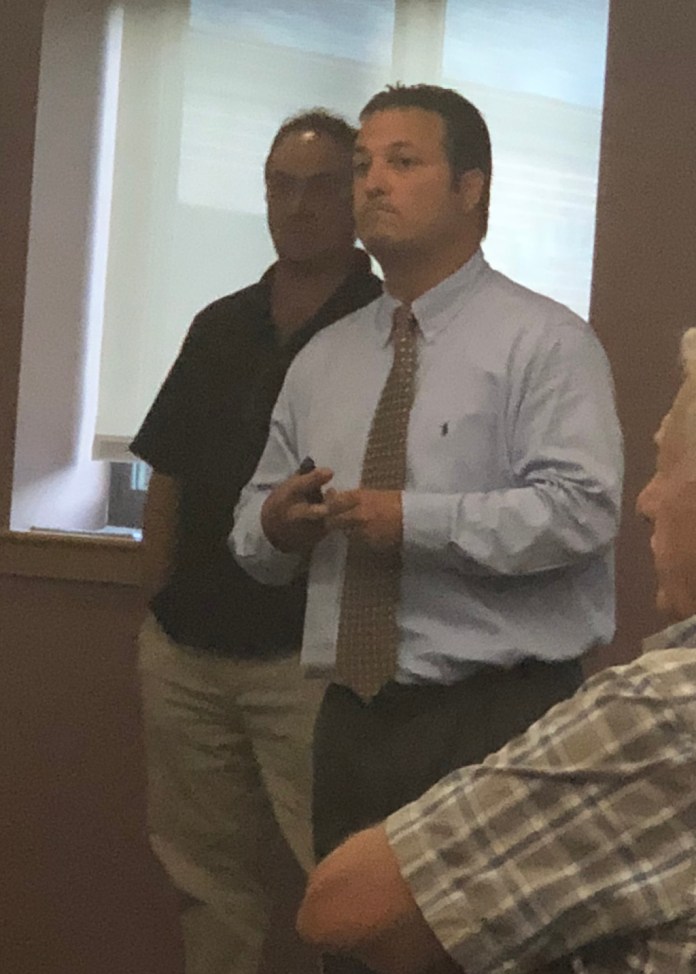
BURRILLVILLE – Town officials are considering a project to rehabilitate sports facilities at Burrillville Middle School that could see a new synthetic turf field installed, along with a lighted track for running.
Joe Casali of Joe Casali Engineering, Inc. presented an initial cost estimate to the Town Council this week, noting that the minimum price for the capital improvement project would be around $1.9 million.
The firm designed Bulldog Stadium at Bryant University, and Casali has served on the board developing a synthetic field at Scituate High School.
The project in Burrillville is in its conceptual stages, and decisions must be made about the extent to which the town wants to invest in the facilities. The track alone, Casali informed counselors, will cost around $300,000 and the field $850,000.
“There’s also other alternatives you may want to look into,” the engineer said, noting that they could choose just partial lighting for the field, or light up the entire track. “If you want that track to be open to the public, it’s something to think about.”
Additional options include bleachers, restrooms and concession stands.
“You can add alternates to make this thing as grand as you want,” Casali said. “That can really increase the cost. This may not be where you need to go in terms of what the community wants.”
Councilor Raymond Trinque said, “I could see this becoming – with a brand new track – one of the top running places in the state of Rhode Island.”
Trinque said the town may want to consider keeping some sports – such as high school football – on the grass at Alumni Field – in part to lessen the number of lines that would have to be painted on the turf.
“North Smithfield has a synthetic field, and they put every line imaginable on that field, and it looks like a flea market,” he said. “The team that would want to move to synthetic field immediately would be field hockey. Field Hockey is a much better game on a synthetic field.”
Trinque noted that since the football team started playing on a lighted field, attendance has increased, with an average of 400 people attending Saturday morning matches, while more than 1,000 show up at night games.
“It becomes a Friday night event,” he said.
Councilor Donald Fox said he disagrees with the idea of limiting the number of teams that would play at the new facilities.
“If we’re going to build a track in this town we’re going to line it with every sport you can play on it. Your aesthetic for how the field would look is irrelevant,” Fox said to Trinque. “Let our biggest problem be scheduling. You want to be able to parlay it to every sport that you can.”
Trinque noted that to move high school football, the town would likely need to install new bathrooms and dressing rooms.
Public Works Director Jeffrey McCormick noted that there are both benefits and drawbacks to synthetic turf.
“You can use that field all day long,” McCormick said. “It always looks good. You don’t need to line it. The cons are: You have to have money in storage to clean the carpet.”
Casali noted that generally, synthetic fields need to be cleaned quarterly.
“Bodily fluids – it’s just part of the game,” he said.
Casali noted that while on the surface, it seems as though the cost of synthetic fields would be higher, the long term price comes down when you add in things such as the maintenance required for keeping several grass fields looking good.
“It’s also a liability,” said Casali. “It’s like buying a brand new $100,000 police car. It’s a super asset for the community but it’s also something to think about from a liability standpoint.”
“I think kids and coaches prefer natural field,” he added.
Over a 30 year period a synthetic field will need to be replaced twice, Casali said, while a grass field will be replaced three times.
Councilor David Place requested a copy of the maintenance cost analysis from the similar project the engineer worked on in Scituate.
“The primary reason I opposed the bike path when the bike path was built was maintenance,” Place said. “I would like to see the analysis of the long term cost.”






